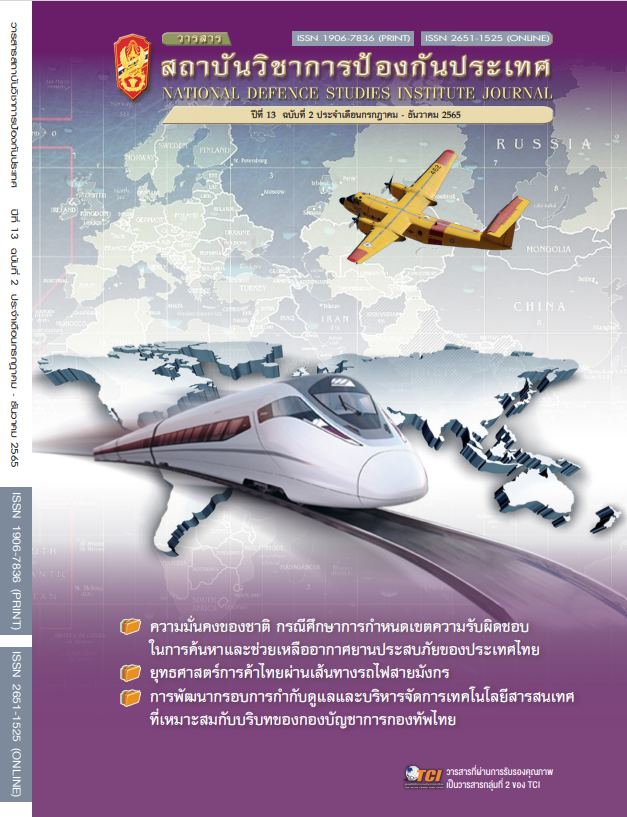Development of the Appropriate Information Technology Management and Governance Framework, The Royal Thai Armed Forces Headquarters
Main Article Content
Abstract
The objectives of this research were to 1) examine the Royal Thai Armed Forces Headquarters' information technology governance and management issues, 2) examine the relationship between the issues and the COBIT 2019 standard framework, and 3) develop an appropriate framework for governing and managing information technology in headquarters contexts. Both quantitative and qualitative methodologies were used in the study design, with the COBIT 2019 framework serving as the primary notation. Questionnaires were utilized to collect empirical data from 350 respondents working at the armed forces headquarters (100 percent response rate); in addition, interviews were conducted with many top military officials. The data analysis used the following statistics: 1) descriptive statistics (frequency distribution, percentage, mean, and standard deviation) and 2) inferential statistics (multiple linear regression). Comparative analysis was used to assess the qualitative data in order to identify between divergent and comparable viewpoints on each subject. The findings indicated that high levels of information technology governance and management problems were caused by 1) knowledge and understanding of information technology laws, 2) the code of information technology ethic declaration, 3) lacks the interest of the officers of the armed forces in further education and self-improvement to keep up with the latest modernization of information technology, and 4) unstable network connections and unserious operating collaborations by information security. It also pointed out that the standard framework of the information technology governance and management were in high demand. It included the needs of assessment, commanding and monitoring, alignment, planning, system preparation, delivery, services and supports, creation, procurement, and implementation. Regarding the hypothesis testing, it found that the governance and management problems influenced the COBIT 2019 framework applying in the armed forces headquarters (R2 was between .025-.231, which generated 80 influence equations). The highest influence equation described the following factors: the code of IT ethics declaration, inconsistency of IT expenses with the organizational processes, delayed resolution of IT complaints, and network connection instability caused the management of information technology in terms of delivery, services, and support in the security service management process to increase and decrease at effect size (R2) .231.
Article Details

This work is licensed under a Creative Commons Attribution-NonCommercial-NoDerivatives 4.0 International License.
The articles, images, tables, graphs, written content, and opinions published in this journal are solely those of the authors and do not necessarily reflect the views or positions of the National Defence Studies Institute or its academic affiliates.
References
กรมกำลังพลทหาร. (2563). หนังสือบันทึกข้อความขอความอนุเคราะห์ข้อมูลยอดกำลังพลของกองบัญชาการกองทัพไทย (พื้นที่แจ้งวัฒนะ) เพื่อใช้ในการทำวิทยานิพนธ์. กรุงเทพฯ: กองบัญชาการกองทัพไทย.
Ahsan, A. (2010). The rise and fall of R & D center's ‘Quality Management Department’ of a major ICT Based Chinese Organization in Pakistan: An exploratory, explanatory and analytical case study of core reason of rise and fall and corresponding soft benefits and dis-benefits for the overall organization. In Proceedings of the 2010 IEEE 17Th International Conference on Industrial Engineering and Engineering Management (p.903-910). China: Xiamen
Franc, G. (2021). COBIT 2019-Review of the Framework and its Major Concepts. Retrieved from https://www.linkedin.com/pulse/cobit-2019-review-framework-its-major-concepts-gr%C3%A9gory-franc
Krejcie, R. V. & Morgan, D.W. (1970). Determining Sample Size for Research Activities. Educational and Psychological Measurement, 30(3), 607-610.
Montequin, V. R., Counsillas, S., Ortega, F., & Villanueva, J. (2014). Analysis of the Success Factors and Failure Causes in Information & Communication Technology (ICT) Projects in Spain. Procedia Technology, 16, Retrieved from https://www.sciencedirect.com/science/article/pii/S2212017314002801
Whittaker, B. (1999). What went wrong? Unsuccessful information technology projects. Journal of the Information Management and Computer Security, 7(1), 23-29


